Video
tumblr
Invertebrates galore!
How wonderful it was been to really get out and into the field of the animals we have been working with, learning about in class, and taking with expert on the other field trips I’ve attended. Especially since going to the coast ways a way to escape the intense layers of smoke coming in to Sonoma County that Thursday evening. We found some incredibly interesting animals in many different little habitats!
The tide was lowering as we arrived so as the trip went on we got to go deeper and deeper into the intertidal zone, seeing more phylums and species within them revealed. The most exciting part about this trip to the Bodega Head was going with my Invertebrate Biology class and getting to truly nerd-out on all of the amazing organisms to be found. Northern California beaches are teaming with large invertebrates that I had always seen growing up but never understood. Finally, at this stage in class and my general understanding of marine biology as a Biology student I am able to appreciate the diversity and the strength of these creatures in the intertidal. However, I do of course have a few favorites!
The most interesting and beautiful to me were the chitons! I loved how much they can range in colors and sizes and we saw a great many of them that is for sure!
Other Good-to-Know facts about the Chitons of Northern California ! (Sources are hyperlinked) -They belong to the Phylum Mollusca and Class Polyplacaphora meaning roughly “Many Plate Bearing” -They reside throughout the entire Pacific coast from “Northern Mexico to Northern British Colombia”, Canada -The shell plates are partially or fully embedded in the “girdle” tissue, this muscular tissue provides support for the shell and the body and for some species also be used in food capture like a net. -Most species are separate sexes but are not dimorphic. Some species are hermaphroditic and can self-fertilize, but their male reproductive system matures before their female one in most cases.





0 notes
Text
Rooms of Gnarly Jars and Incredible History
A brief journey through the California Academy of Sciences
Having been to the California Academy of Sciences many times, I am quite familiar with the layout of the floors and the extensive research that goes on through the organization. Nothing quite prepared me, however, for the expansiveness of the amount of collected specimens that exist within the section invertebrate section, let alone all the preserved organisms held in the buildings entirety.
My class had the pleasure of having a tour of this collection and being lead by a very informative and incredibly kind lead scientist and curator. She took the time to lead us down many isles of the Invertebrate collection, pulling out specific specimen to examen and tell us a story about. The immensity of the diversity that can be found in the invertebrate community of the Cal Academy of Science is a beautiful culmination of passionate people like herself that work hard everyday to preserve the knowledge that these creatures have been able to provide and continue to provide for science.
One of the most interesting facts was learning about how scientist are able to (with the correct verification) come in and extract DNA, tissue samples, or just observe the specimen’s morphology. Some of the specimens in the collection are incredibly rare and are vital in retaining the information and knowledge of the past and therefore are incredibly important for our understanding of the future and without proper preservation by teams of people like those in this department of the Cal Academy of Sciences they would be completely lost.
Other Good-to-Know facts about the Whale Lice! (Sources are hyperlinked) *Third to last picture below* -A Whale louse (multiple being Whale Lice) are in fact not lice like humans know them to be. Whale louse are in the family Cyamidae in the family Amphipoda, so these little hitchhikers are Crustaceans! -There is no real evidence that these are actually harmful to the whales. It has only been really proven that they help take out dying skin on wounds that could lead to infection. In that way they are actually helping the whale! As scary or gross as they look! -Whale lice can spread from the mother to calf during birth or feeding. -Studying Whale Lice has given us insight into the evolution of whales since they have been “riding” along with them for incredibly long.









0 notes
Text
Wee Lil’ Slugs
Part 2 Day 2 of (Half) A Classes Adventure Through the Elkhorn Slough
After exploring the equipment used to make under water scientific discoveries, and admiring the engineering skills that so many have to bring dreams of experiencing these other worlds to life, a trip to go see some of the animals and life that inspire us all to study what we do!
We made our way (slightly late) to a kayaking company down the road of MBARI and got in our bright yellow jackets and life vests. After pairing up and playing a low-level ice breaker with our group we were off! Paddling down in early afternoon, gliding against the low rolling waves of the Elkhorn Slough. Passing the “Bachelor” otter pad and a large grouping of Sea lions wailing from a strip of rock framing the channel of the slough, we paddled along talking about the large beautiful birds and making our way in.
While paddling down, we passed over a patch of Seagrass. The ropes of the thin blades of green floating at the surface of the water just hinting at the immensity of the green forrest underneath. Seagrass provides an important habitat for many creatures in the Elkhorn Slough and there have been major efforts just in the last few years to restore the Seagrass to its original density.
As we paddled gently across the bed, gliding over the top being careful not to rip up the shoots, Dr. Lee spotted a very small and green Phyllaplysia taylori, her eyes like a hawks for invertebrate life. Softly she scooped up the little slug, inspecting the few vertical white lines going from anterior to posterior and the small black dots and lines running laterally. No bigger than roughly 35mm, this little mesograzer helps clean epiphytes off the seagrass, keeping the seagrass growing healthily. “...epiphytes and diatoms that can smother the seagrass, compromising the photosynthetic capacity of the seagrass blades” Mesograzers, like Phyllaplysia taylori, remove the epiphytes and diatoms so that the seagrass can effectively persist and provide for the Elkhorn Slough.
Due to paddling and enjoying the moment, I did not take my phone out to take a picture of the Phyllaplysia taylori we looked at so I have provided a web search picture on one.
Other Good-to-Know facts about the Phyllaplysia taylori *Pictured Below* (Sources are hyperlinked) -Taxonomy K: Animalia~P: Mollusca~C: Gastropoda~SubC: Heterobranchia~InfraC: Euthyneura~SubterC: Tectipleura~Order: Aplysiida~SuperF: Aplysioidea~F: Aplysiidae~G: Phyllaplysia~S: Phyllaplysia taylori -Common Names: Zebra leafslug, Taylor's sea hare, green sea slug -This species is hermaphroditic -This is not a nudibranch! Even if it appears like it should be
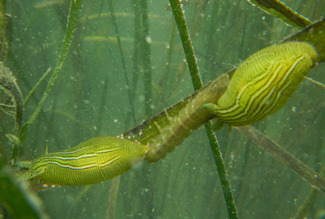
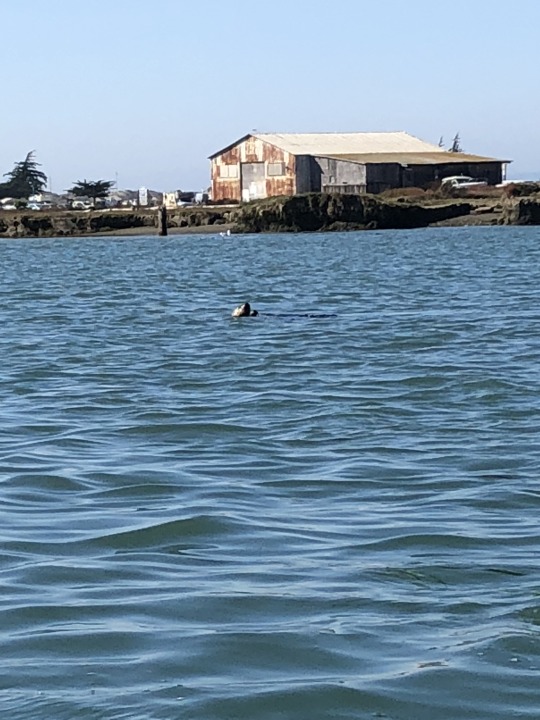
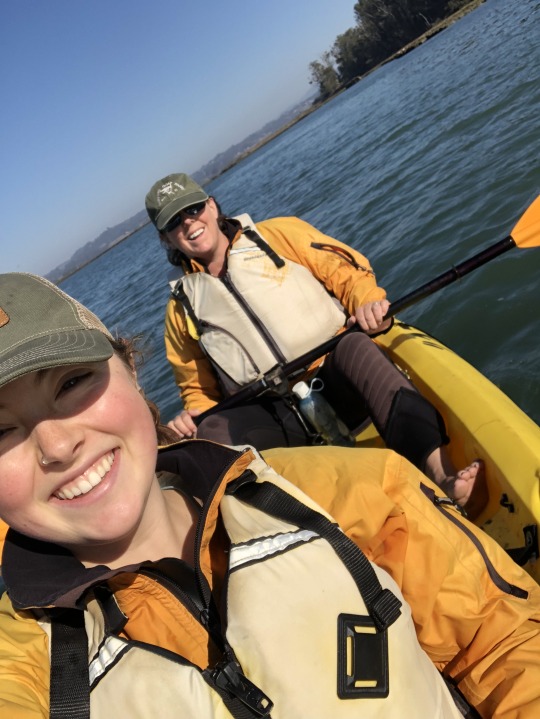
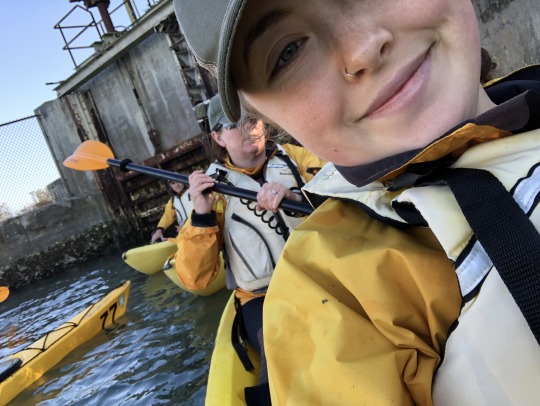
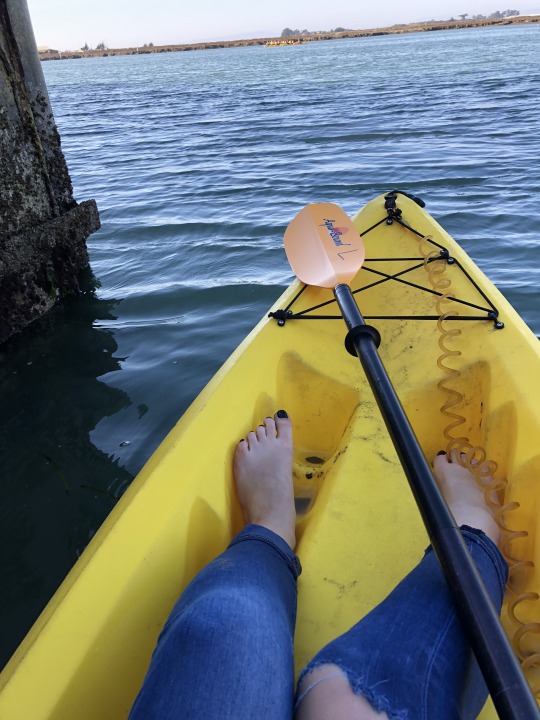
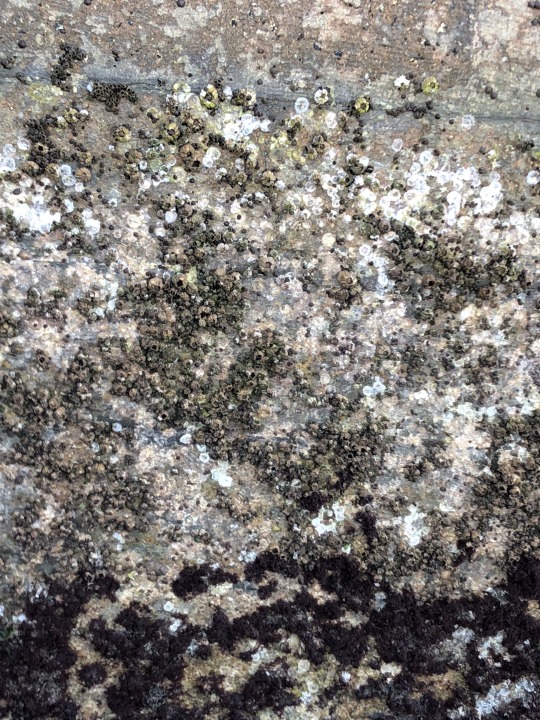
0 notes
Text
The Power (and Complication) of Science!
Part 1 of Day 2 of the 2k18 Monterey Extravaganza!
It is always exciting to meet someone who at one time was a budding biologist like myself and those in my class, and now is a fully blossomed scientist who has been acknowledged for their contributions to our knowledge of species diversity and continues to persevere in the name of scientific exploration. Our third guide of the trip was Shannon Williams, a powerful woman who exemplified the beautiful balance between being a professional in innovative science work, being a mother, and seemingly being a social and active person. Meeting people like her inspire me due to their excellence in their field and their approachability. Shannon’s research is complex and ever shifting and you could really see the passion and excitement that fuels it for her coming out while she was talking.
Reading about studies done at Institutes like the Monterey Bay Aquarium Research Institute (MBARI) by scientists like Shannon are fantastic, but actually getting to see the type of equipment and facility used to do that research was something else entirely. The machinery on the “Day-use” ship we got to tour has the capability to not only capture video and take recordings of certain oceanic conditions of the water, but it actually can capture animals! Using the control room at the front of the ship, the pilots navigate and operate this sea-floor rover under the lead of scientist like Shannon looking to collect different organisms. Having a chance to walk inside the institute and see a real genetics lab and the 10 meter pool used to test equipment was a very unique experience that I am very fortunate to have had!
The rocket ship like equipment pictured is the cutting edge of oceanographic research. It is being developed to measure incredibly closely levels of salinity, temperature, sunlight, etc. While also now capturing samples and possibly some animals as well. These torpedo like machines can be running along a predetermined path so that they can be collecting and sampling in all conditions (time of day, different depths, etc.) without humans having to pilot it. This can provide major insight into some of the gaps left by the inability for humans to be surveying constantly 24/7.
Other Good-to-Know facts about the Yeti Crab *Pictured Below* (Sources are hyperlinked) This crab was discovered by Shannon Williams and her team while studying hydrothermal vent communities South of Easter Island. -The crab they found was not just a new species, but also a new family of crab. The family was named Kiwaidae and the species name is Kiwa hirsuta. -The fur on the legs of these deep-sea-dwelling-hydrothermal-vent-living-animals are used to essentially “Farm bacteria” being producing and flourishing due to the hydrothermal-vent activity. Although this idea of the Yeti-crab growing its own bacteria on its furry legs is still being worked out, it is not very unlikely due to other crabs doing using similar tactics to ensure a food supply. -Yeti crabs have, in fact, no eyes. -In 2015, another species was added to this family. The Kiwa tyleri located in the East Scotia Ridge just off Antartica. These crabs live in a sort of sweet hydrothermal sweet spot where the waters that are usually just over freezing can reach incredibly high temperature. However, anything outside that small vicinity the crabs will freeze fairly instantly.
Fun fact: The data collecting torpedos are incredibly tough and one came back with a White Shark’s bite mark and a tooth stuck!



0 notes
Text
Jellies and Inverts Galore!
The Monterey Bay Aquarium is lucky to have such the incredible jelly expert and lover as the man that gave us the tour around the backside of the Jelly exhibit and took us behind the scenes to see the up and coming newest members to the MBA Jelly family (not pictured here) yet to make their reveal! The group and myself found out some majorly fascinating things about how the MBA is fairly cutting edge in the science and capability of housing and carrying for these incredibly delicate animals. With the Monterey Bay for a backyard, it is to hard to find some amazing specimens to bring back to be cultured, but it is giving them the best quality of life that captures the attention and maintains being the focus for these hard working individuals in this department of the aquarium and incoming interns. Pictured in the short gif are comb jellies, which in particular have stolen the fancy of our more than excited tour guide. From breeding small rotifera and growing algae for the cnidarians and ctenophora, the team at work for keeping up and always working to improve the lives of the jellyfish at the MBA do us viewers a huge service, bringing these ocean creatures right to our own eyes from the comfort of dry land!
Fun fact about Comb Jellies (what is pictured) coming from the Monterey Bay Aquarium website: “Comb jellies will eat other jellies larger than themselves by biting off chunks with special cilia structures in their mouth”
Comb jellies themselves are hard to keep alive and require very specifically designed tanks to simulate the ocean currents and movement with out squishing or squashing them! At the time it was built, the specialized Jelly tank used for the MBA exhibit was the biggest of its kind! It has been surpassed since then but the MBA remains as a leader in innovative aquarium techniques.
Other Good-to-Know facts about the Comb Jellies! (Sources are hyperlinked) -While they are called “Jellies”, they are, in fact, not even in the same phylum as Jellyfish. Jelly fish are in Phylum Cnidaria whereas the Comb Jellies are within the phylum Ctenophora. -One very particular difference between Jellyfish and Comb Jellies is the Ctenophora’s tentacles do not sting they are “Sticky cells” -Ctenophores have a simple life cycle. Other than the few benthic ctenophores species, ctenophores are holoplanktonic, meaning from gamete to adulthood ctenophores are free-floating in the ocean and at the whim of where the current takes them.
Fun fact about Comb Jellies (what is pictured) coming from the Monterey Bay Aquarium website: “Comb jellies will eat other jellies larger than themselves by biting off chunks with special cilia structures in their mouth”


0 notes
Text
Glorified Snails? Good Eatin’? Or A Step Toward Sustainable Food Sourcing? Well...All of Them!




The small collection of Invertebrate Biology students, adorned with sweaters and small backpacks, stood at the front of the Monterey Abalone Co. With locals and the like intermittently stopping in to listen to the manager, a man no older than 35 equipped with an ability to disregard and talk over the wailing seagulls with uncanny grace, inform and report on the current state of Aquaculture. Our glistening foreheads and shifting bodies battled the hot sun of a clear late morning Monterey in October until we were led into the work place by our dark green and beige clad Gastropod leader and aficionado.
My birkenstocks made their slow way down a ladder through a whole in the wharf to a work straight out of a “best of where to work show”. Sea lions napped on the wood pillars, the boards we stood on swayed under our weight, the smell of kelp and the sea hung heavy enough to never allow you to forget that three feet under the thin wood beneath your feet was the ocean. As we walked, our tentative steps were calculated as not to slip on loose seaweed threatening to send us into the lapping water under us. As our cautious steps brought us slowly to the cages our Abalone leader danced his boots around to show us this or that, making all of us catch our breath and doubt his own comfortability.
With one foot dangling over the side of the walkaway he plucks a four-year old abalone out of a collecting bin and offers it to the group. Being the closest and eager to get my hands on some invertebrates I carefully (much more carefully than he or the the works behind him I might add) set the small animal on my hand. Immediately the mucous slime set in the and slight shifting of the foot could be felt, ticking the outer edges of my palm. Entranced by the reality of this under-the-wharf-farm being a work place, and the small skeleton shrimp head banging off the rims of the cages, my mind wandered off the slippery wood and his dangling foot.
Here is the thing about Abalone though, they are a totally great food source for humans, along with a lot of other aquatic life. As described and slightly (wonderfully) ranted about by our tour guide and Abalone farm manager, we as a humanity need to be turning our attention to the ocean for more sustainable and realistic sources of protein (if done correctly). Although catching wild abalone is difficult due to previous high exploitation and slower growing rates compared to many animals, having farms situated in naturally circulating conditions is a huge step in the right direction for aquaculture. However great this is, places like the Monterey Abalone Company are not only at the whims of nature like an kind of agricultural farm year to year, but also the ticking time clock of rising ocean levels threatening to kick them out of their current facility on the end of the wharf.
As humanity works to find new solutions to unsustainable food production and addressing Global Climate Change, looking to the ocean and caring for it must become more of a priority. One of the most interesting points our leader talked about was the fact that many are so resistant toward touching any sort of MPAs (Marine Protected Areas) even to help rehabilitate the ecosystem because technically it is humans meddling. However these ecosystems are mainly in danger of being out of balance due to the intense impact humans have had on climate change and therefore the drastically changing ocean conditions. We do not have the luxury any longer to throw up our hands and say “let nature be nature” because up the bay in a none MPA we do whatever we want to the water and expect it not to have an effect on the parts we don’t want effected.
In short, Abalone are cute little slimy Gastropods that at one point I died to have breaded and placed on a plate in front of me! Although I may not be as excited for this source of protein myself as many might be and I once was as well, I still can see the massive potential that aquaculture farming has, and I have to say, those little skeleton shrimp dancing all around would make even this slightly “sketchy” job worth it!
Other Good-to-Know facts about Abalone! (Sources are hyperlinked) - During the course of this year (2018) the California Department of Fish and Wildlife has been drafting, submitting, and revising a Fishery Management Plan in order to support the Abalone’s survival up the California coast, while still allowing for healthy amount of harvesting for food. -Hunting for wild marine gastropods like the Red Abalone off the California coast has resulted in many accidents and usually more than one or two fatalities a year. The Northern California coast where they reside in waters just deep of the rocky intertidal make for extreme conditions for any diver to face. The crashing waves, blunt rock face cliffs, and great white sharks, can catch even a fairly experienced diver off their guard. -The San Francisco Chronicle in their article show casing a Abalone Farm like the one we went to near the bay area states “The Monterey Bay Aquarium’s Seafood Watch program puts farmed abalone in systems like this one in the “best choice” category for seafood sustainability.” Though “wild” has a certain prestige attached, farmed seafood like the abalone documented in this article and those like the ones produced at the Monterey Abalone Co. are used by chefs and families a like to enjoy this delicacy without contributing to the depletion of the Abalone population.
0 notes